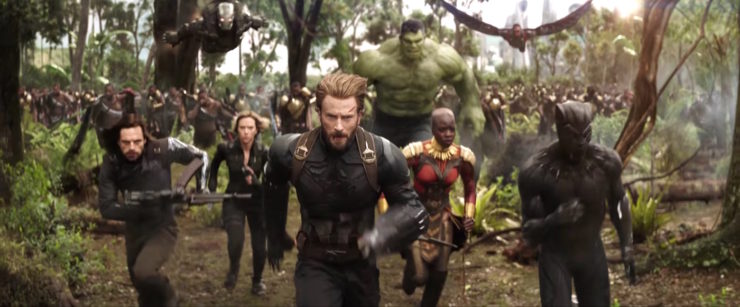[This article is definitely going into spoilers for Avengers: Infinity War. For those who still haven’t seen it, take the opportunity that Peter Parker passed up and turn back now. I mean, the Blu-ray’s out.]
It was a busy day between Avengers: Infinity War and Avengers 4 when Reddit user u/K5cents attempted a simulation: What were the odds of Captain America, Iron Man, Hulk, Thor, and Black Widow surviving Thanos’ Snap? It was a good attempt, but didn’t quite get the model right—we’re not guaranteed that half of the heroes survive, just half the population—and, by the way, Hawkeye’s got a 50/50 chance of still being alive, too. Do you really expect him to sit Avengers 4 out?
So, what is the probability of the 6 original Avengers surviving, based on Thanos’ death-coin-for-everyone? Let’s find out.
In Infinity War, Thanos says the Snap would be completely indiscriminate. This means that for each living “soul-bearing” entity X (presuming this is the threshold for the Soul Stone), the probability of X surviving the Snap is
P(X survives) = 1/2
independent of any other consideration. Individual dustings are what you would call independent, identically distributed (“IID”) events.
Thus, the probability of your favorite n Avengers surviving (or, really, favorite n soul-bearing entities) is
P(these n specific souls I care about survive)
= P(soul 1 survives) * P(soul 2 survives) * … * P(soul n survives) = (1/2)n.
Fair coins, not being in the business of discriminating, don’t care if they land heads or tails. The same can be said for all your favorites dying: since each soul’s survival is independent of the others,
P(these n specific souls I care about die) = (1/2)n.
In particular, we can ask, what’s the probability that the original Avengers cast all happen to Snapvive for the endgame (before any inevitable time travel shenanigans begin)?
P(Stark, Thor, Banner, Cap, Widow, Hawkeye all survive) = (1/2)6 = 1/64 = 1.5625%.
We can ask similar questions, that all follow the one rule above. For one, what’s the probability of exactly 3 of the original Avengers, the mythical “half”, surviving? To answer this we need to use binomial probabilities, involving combinations:
P(exactly 3 of Stark, Thor, Banner, Cap, Widow, Hawkeye survive)
= 6C3 * (1/2)6 = 20/64 = 31.25%.
A safer hope is “at least half”:
P(at least 3 of Stark, Thor, Banner, Cap, Widow, Hawkeye survive)
= (3 or 4 or 5 or 6 of these 6 survive)
= (6C3 + 6C4 + 6C5 + 6C6) * (1/2)6 = (20+15+6+1)/64 = 42/64 = 65.625%,
These are damn good odds for Earth; nearly 2/3 chance at least half of them survived.
Let’s swing the needle into the extremes. What’s the chance that all the MCU heroes survive (or, equivalently, die, franchise be damned)? We’ll count a good number of all the living MCU heroes we’ve seen as of the Snap:
MCU_heroes_as_of_snap = {
"Iron Man","Thor","Hulk","Captain America","Black Widow","Hawkeye",
"Nick Fury","Maria Hill",
"War Machine","Scarlet Witch","Falcon","Winter Soldier",
"Ant-Man","Wasp",
"Drax","Groot","Rocket","Star-Lord","Nebula","Mantis",
"Doctor Strange","Wong",
"Spider-Man",
"Black Panther","Shuri","Okoye","Nakia","M'Baku","W'Kabi"}
For this count I get 29 individuals. (Of course we could list on and on… or you could pare it down. Argue amongst yourselves.) The probability all of them survive is
P(all 29 heroes survive) = (1/2)29 = 1/536,870,912,
much lower odds than the sample average 1/14,000,605 Strange gave for a “win”. Clearly, some could die.
By fair coin symmetry and the fact that 29 is an odd number, the probability that at least half of these 29 survives is… exactly 1/2. Why? Because
P(at least 15 of 29 survive) = P(exactly 15 or 16 or 17 or … or 28 or 29 out of 29 survive)
=P(exactly 14 or 13 or 12 or … or 1 or 0 out of 29 die),
which is the same as
P(at least 15 of 29 die) = P(exactly 15 or 16 or 17 or … or 28 or 29 out of 29 die).
Together, these two cover all cases (probability 1) and are equal.
If you wish to take the Monte Carlo route here and attempt simulation (say, checking 14,000,605 randomly-generated cases yourself to see how often certain people live), there’s a mild issue beyond the one mentioned earlier: most of our puny human-constructed computer simulations cannot be “random” to the level we’d like because they are what we call pseudorandom: mathematically generated to look random, but based on random initial data piped through deterministic (but hard to invert) functions. If you don’t think pseudorandom is good enough, you may, of course, you use physical means of randomness, like a hardware RNG, or, say, a camera trained on a wall of lava lamps.
Given the sheer number of life forms in the universe, the Law of Large Numbers will make sure that Big T’s trillions of IID flips get his megadeath very close to half. As we well know, though, many more will die soon afterwards.
All this said, if you run some simulations anyway, I think they’ll go a bit quicker than for Dr. Strange.
Suppose Michael Carlisle (@docintangible) is a mathematician and writer living in New York.










